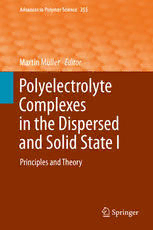
Polyelectrolyte Complexes in the Dispersed and Solid State I: Principles and Theory PDF
Preview Polyelectrolyte Complexes in the Dispersed and Solid State I: Principles and Theory
Advances in Polymer Science 255 Martin Müller Editor Polyelectrolyte Complexes in the Dispersed and Solid State I Principles and Theory 255 Advances in Polymer Science EditorialBoard: A.Abe,Tokyo,Japan A.-C.Albertsson,Stockholm,Sweden G.W.Coates,Ithaca,NY,USA J.Genzer,Raleigh,NC,USA S.Kobayashi,Kyoto,Japan K.-S.Lee,Daejeon,SouthKorea L.Leibler,Paris,France T.E.Long,Blacksburg,VA,USA M.Mo¨ller,Aachen,Germany O.Okay,Istanbul,Turkey B.Z.Tang,HongKong,China E.M.Terentjev,Cambridge,UK M.J.Vicent,Valencia,Spain B.Voit,Dresden,Germany U.Wiesner,Ithaca,NY,USA X.Zhang,Beijing,China Forfurthervolumes: http://www.springer.com/series/12 Aims and Scope TheseriesAdvancesinPolymerSciencepresentscriticalreviewsofthepresentand futuretrendsinpolymerandbiopolymerscience.Itcoversallareasofresearchin polymerandbiopolymerscienceincludingchemistry,physicalchemistry,physics, materialscience. The thematic volumes are addressed to scientists, whether at universities or in industry,whowishtokeepabreastoftheimportantadvancesinthecoveredtopics. AdvancesinPolymerScienceenjoysalongstandingtraditionandgoodreputa- tioninitscommunity.Eachvolumeisdedicatedtoacurrenttopic,andeachreview critically surveys one aspect of that topic, to place it within the context of the volume.Thevolumestypicallysummarizethesignificantdevelopmentsofthelast 5to10yearsanddiscussthemcritically,presentingselectedexamples,explaining and illustrating the important principles, and bringing together many important referencesofprimaryliterature.Onthatbasis,futureresearchdirectionsinthearea canbediscussed.AdvancesinPolymerSciencevolumesthusareimportantrefer- ences for every polymer scientist, as well as for other scientists interested in polymerscience-asanintroductiontoaneighboringfield,orasacompilationof detailedinformationforthespecialist. Review articles for the individual volumes are invited by the volume editors. Singlecontributionscanbespeciallycommissioned. Readership:Polymerscientists,orscientistsinrelatedfieldsinterestedinpoly- merandbiopolymerscience,atuniversitiesorinindustry,graduatestudents. Specialoffer: For all clients with a standing order we offer the electronic form of Advances in PolymerSciencefreeofcharge. Martin Müller Editor Polyelectrolyte Complexes in the Dispersed and Solid State I Principles and Theory With contributions by (cid:1) (cid:1) (cid:1) A.G. Cherstvy M.A. Cohen Stuart C. Cramer N.I. Lebovka (cid:1) S. Lindhoud (cid:1) A.H.E. Mu¨ller (cid:1) D.V. Pergushov (cid:1) M. Scho¨nhoff (cid:1) R.G. Winkler (cid:1) (cid:1) A.A. Zezin A.B. Zezin Editor MartinMu¨ller LeibnizInstituteofPolymerResearchDresden DepartmentofPolyelectrolytesandDispersions HoheStraße6 D-01069Dresden Germany ISSN0065-3195 ISSN1436-5030(electronic) ISBN978-3-642-40733-8 ISBN978-3-642-40734-5(eBook) DOI10.1007/978-3-642-40734-5 SpringerHeidelbergNewYorkDordrechtLondon #Springer-VerlagBerlinHeidelberg2014 Thisworkissubjecttocopyright.AllrightsarereservedbythePublisher,whetherthewholeorpartof the material is concerned, specifically the rights of translation, reprinting, reuse of illustrations, recitation,broadcasting,reproductiononmicrofilmsorinanyotherphysicalway,andtransmissionor informationstorageandretrieval,electronicadaptation,computersoftware,orbysimilarordissimilar methodologynowknownorhereafterdeveloped.Exemptedfromthislegalreservationarebriefexcerpts inconnectionwithreviewsorscholarlyanalysisormaterialsuppliedspecificallyforthepurposeofbeing enteredandexecutedonacomputersystem,forexclusiveusebythepurchaserofthework.Duplication ofthispublicationorpartsthereofispermittedonlyundertheprovisionsoftheCopyrightLawofthe Publisher’s location, in its current version, and permission for use must always be obtained from Springer.PermissionsforusemaybeobtainedthroughRightsLinkattheCopyrightClearanceCenter. ViolationsareliabletoprosecutionundertherespectiveCopyrightLaw. The use of general descriptive names, registered names, trademarks, service marks, etc. in this publicationdoesnotimply,evenintheabsenceofaspecificstatement,thatsuchnamesareexempt fromtherelevantprotectivelawsandregulationsandthereforefreeforgeneraluse. While the advice and information in this book are believed to be true and accurate at the date of publication,neithertheauthorsnortheeditorsnorthepublishercanacceptanylegalresponsibilityfor anyerrorsoromissionsthatmaybemade.Thepublishermakesnowarranty,expressorimplied,with respecttothematerialcontainedherein. Printedonacid-freepaper SpringerispartofSpringerScience+BusinessMedia(www.springer.com) Preface Nearly one decade ago, a two volume edition “Polyelectrolytes with Defined MolecularArchitecture”editedbyM.SchmidtappearedintheseriesAdvancesin PolymerScienceandsummarizedprogressinthefieldatthatdate.Withinthetotal of 11 chapters, one was dedicated to polyelectrolyte complexes, which addressed interpolyelectrolyteandpolyelectrolyte/surfactantcomplexesaswellastheoretical aspectsofpolyelectrolyte(PEL)complexation. This new two-volume edition “Polyelectrolyte Complexes in the Dispersed and Solid State: Principles and Applications” is intended to extend the content of this former chapter by bringing together selected state-of-the-art contributions on principlesandtheory(VolumeI)aswellasoncurrentapplicationaspects(VolumeII) of polyelectrolyte complex (PEC)-based particles and soft matter. In Volume I, progress and new knowledge on theoretical aspects of electrosorption phenomena betweenPELandoppositelychargedsurfaces(A.G.CherstvyandR.G.Winkler)and of the practically always apparent aggregation and clustering tendency of PEC particles (N.I. Lebovka) are reviewed. Recently identified important dynamic aspects of ion conductivity (C. Cramer and M. Scho¨nhoff) within PEC soft matter and relaxation phenomena within PEL/protein PEC particles (S. Lindhoud and M.A. Cohen-Stuart) as well as structural aspects of interpolyelectrolyte com- plexes of novel synthetic polyionic species with nonlinear topology and polymer– inorganic hybrids (D.V. Pergushov, A.A. Zezin, A.B. Zezin, A.H.E. Mu¨ller) are reviewed.InVolumeII,prominentrecentapplicationsofPECparticlesarereviewed togetherwithanoutlineofrelevantkeypropertiesconcerningcolloidalstability,size, shape, compactness, surface, and biointeraction. The use and tailoring of PEC particle-modifiedrelevantsurfacesforpapermaking(C.AnkerforsandL.Wagberg), solid–liquid separation and water treatment (G. Petzold and S. Schwarz) are addressed.ThelastthreecontributionsreviewPECapplicationsinthelifesciences, including the role of PEL/protein complex assemblies in food (S. Bouhallab and v vi Preface T.Croguennec),theuseofDNA/polycationcomplexesforgenedeliveryandprotec- tion(A.Bertin),andthepotentialofsizableandshapablenanosizedPECparticlesin pharmaceuticalapplicationssuchascontrolleddrugrelease(M.Mu¨ller). Dresden,Germany MartinMu¨ller Contents StrongandWeakPolyelectrolyteAdsorptionontoOppositely ChargedCurvedSurfaces ..................................................... 1 RolandG.WinklerandAndreyG.Cherstvy AggregationofChargedColloidalParticles ................................ 57 NikolaiI.Lebovka IonConductioninSolidPolyelectrolyteComplexMaterials .............. 97 CorneliaCramerandMonikaScho¨nhoff RelaxationPhenomenaDuringPolyelectrolyteComplexFormation .... 139 SaskiaLindhoudandMartienA.CohenStuart AdvancedFunctionalStructuresBasedonInterpolyelectrolyte Complexes .................................................................... 173 DmitryV.Pergushov,AlexeyA.Zezin,AlexanderB.Zezin, andAxelH.E.Mu¨ller Index .......................................................................... 227 vii AdvPolymSci(2014)255:1–56 DOI:10.1007/12_2012_183 #Springer-VerlagBerlinHeidelberg2013 Publishedonline:15March2013 Strong and Weak Polyelectrolyte Adsorption onto Oppositely Charged Curved Surfaces RolandG.WinklerandAndreyG.Cherstvy Abstract Polyelectrolytesaremacromoleculescomposedofchargedmonomersand exhibit unique properties due to the interplay of their flexibility and electrostatic interactions.Insolution,theyareattractedtooppositelychargedsurfacesandinterfaces andexhibitatransitiontoanadsorbedstatewhencertainconditionsaremetconcerning thechargedensitiesofthepolymerandsurfaceandthepropertiesofthesolution.In thisreview,wediscusstwolimitingcasesforadsorptionofflexiblepolyelectrolyteson curved surfaces: weak and strong adsorption. In the first case, adsorption is strongly influencedbytheentropicdegreesoffreedomofaflexiblepolyelectrolyte.Bycontrast, in the strong adsorption limit, electrostatic interactions dominate, which leads to particular adsorption patterns, specifically on spherical surfaces. We discuss the correspondingtheoreticalapproaches,applyingamean-fielddescriptionforthepoly- merandthepolymer–surfaceinteraction.Forweakadsorption,wediscussthecritical adsorption behavior by exactly solvable models for planar and spherical geometries and a generic approximation scheme, which is additionally applied to cylindrical surfaces. For strong adsorption, we investigate various polyelectrolyte patterns on cylinders and spheres and evaluate their stability. The results are discussed in the lightofexperimentalresults,mostlyofDNAadsorptionexperiments. Contents 1 Introduction.................................................................................... 2 2 WeakAdsorption:TheoreticalModel........................................................ 6 2.1 EquationfortheGreenFunction........................................................ 7 2.2 DensityDistributionFunction........................................................... 8 R.G.Winkler(*) TheoreticalSoftMatterandBiophysics,InstituteforAdvancedSimulation, ForschungszentrumJu¨lich,52425Ju¨lich,Germany e-mail:[email protected] A.G.Cherstvy(*) InstituteforPhysicsandAstronomy,UniversityofPotsdam,14476Potsdam,Germany e-mail:[email protected] 2 R.G.WinklerandA.G.Cherstvy 3 WeakAdsorption:ExactlySolvableModels................................................ 8 3.1 PlanarSurface.......................................................................... 8 3.2 SphericalSurface....................................................................... 10 4 WeakAdsorption:WKBApproximation.................................................... 21 4.1 WKBApproximationScheme......................................................... 21 4.2 PlanarSurface.......................................................................... 22 4.3 CylindricalSurface..................................................................... 23 4.4 SphericalSurface....................................................................... 25 4.5 ConformationalPropertiesofAdsorbedPolyelectrolytes............................ 26 5 WeakAdsorption:Discussion............................................................... 27 5.1 ComparingGeometries................................................................. 27 5.2 ComparisonBetweenTheoryandExperiment........................................ 28 6 StrongAdsorption:TheoreticalModel...................................................... 30 6.1 AdsorptionataCylindricalSurface................................................... 31 6.2 AdsorptionataSphericalSurface..................................................... 40 7 LimitationsandFurtherStudies............................................................. 47 8 Conclusions................................................................................... 50 References........................................................................................ 52 1 Introduction Adsorption of charged macromolecules, and polyelectrolytes in particular, onto charged surfaces is of paramount importance in a wide range of technological applications [1, 2], such as surface coating [3], colloid stabilization [4], and paper making[5–7]andforavarietyofbiologicalsystems[8–12].Becauseoftheircharges, mostchargedpolymersarewater-soluble,whichmakestheminterestingcandidates for water-based, environmentally friendly technology. This aspect is even more important for a number ofbiologicalsystems.Here, examplesinclude wrappingof double-stranded DNA in nucleosomes [13–20], adsorption of single-stranded RNA ontotheinteriorofviralcapsides[21–29],andpolyelectrolytemultilayeredvesicles [30,31].Correspondingly,polyelectrolyteadsorptionhasreceivedsubstantialatten- tion for many decades. There are several valuable books and review articles on the subject [8, 9, 32–34]. However, electrostatically driven polymer adsorption shows a broad range of facets, not all of which have been addressed adequately in theliterature. A fundamental step in polyelectrolyte adsorption is the transition from a free state in solution to a bound polymer on an interface. Figure 1 illustrates such a transition for the adsorption of a polyelectrolyte onto spherical colloidal particles [35]. In the unbound state, the polymer chain explores the entropic degrees of freedom, whereas in the bound state the attractive polymer–surface electrostatic interactions dominate [8, 33, 36–39]. These two antagonistic trends dictate the propertiesofadsorption.Theoreticalstudiesoftheadsorptionbehaviorofpolyelec- trolytes onto planar and curved surfaces suggest a phase-transition-like behavior, i.e., a bound polymer state appears at certain critical conditions, which depend upon, e.g., the temperature, the charge density and curvature of the surface, the polyelectrolyte linear charge density and its mechanical persistence [40–44]. An importantaspectofthisreviewistodiscussrecentadvancesonthisissue.
